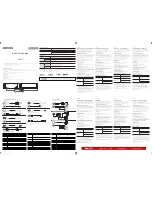
ISO-STIM 01D User Manual
_________________________________________________________________________________________________________________
___________________________________________________________________________
version 4.3
page 8
(
16
) BALANCE trim pot
Trim-pot for compensating for baseline differences of the stimulus when switching
from DIRECT to GATE TTL mode or vice versa. Even if no stimulus is applied in
DIRECT MODE or ANALOG MODE, the baseline of the stimulus isolator may not
be zero. Using this trim pot the stimulus output can be balanced to zero (see below).
(
17
) OFFSET CURRENT trim pot
Trim-pot to compensate for the CURRENT OFFSET of the stimulating electrode in all
input modes. It is recommended to compensate the offsets only in a completely warmed
up condition, i.e. after 30 minutes warm-up time (see below).
(
18
) OFFSET VOLTAGE trim pot
Trim-pot to compensate for the VOLTAGE OFFSET of the stimulating electrode in
TTL mode. It is recommended to compensate the offsets only in a completely warmed
up condition i.e. after 30 minutes warm-up time. Compensation procedure is the same
for current and voltage in the TTL MODE (see below).
OFFSET / BALANCE adjustment
First, the voltage source OFFSET is compensated in TTL mode using the VOLTAGE OFFSET
trim pot #
18
. The same procedure is repeated in TTL mode for current source OFFSET, if the
ISO-STIM 01D is in CURRENT mode using the CURRENT OFFSET trim pot #
17
.
If these baselines are set, the isolation amplifiers may still produce a signal in ANALOG or
DIRECT mode even if no stimulus is applied. This offset signal is balanced to zero using the
BALANCE trim pot.
(
19
) MANUAL TRIGGER button
Button for triggering the ISO-STIM 01D manually
(
20
) INPUT MODE switch
Switch for selecting the INPUT MODE (see Chapter 4.2).
(
21
) GATE TTL connector
BNC connector for the input of a GATE signal in GATE TTL mode (see also
Chapter 4.2)
































